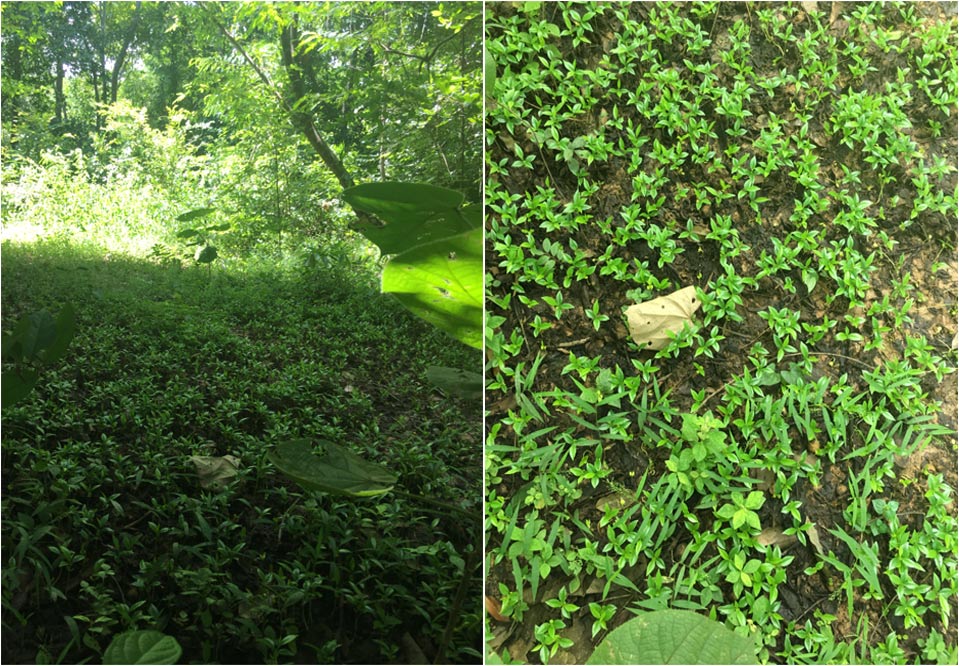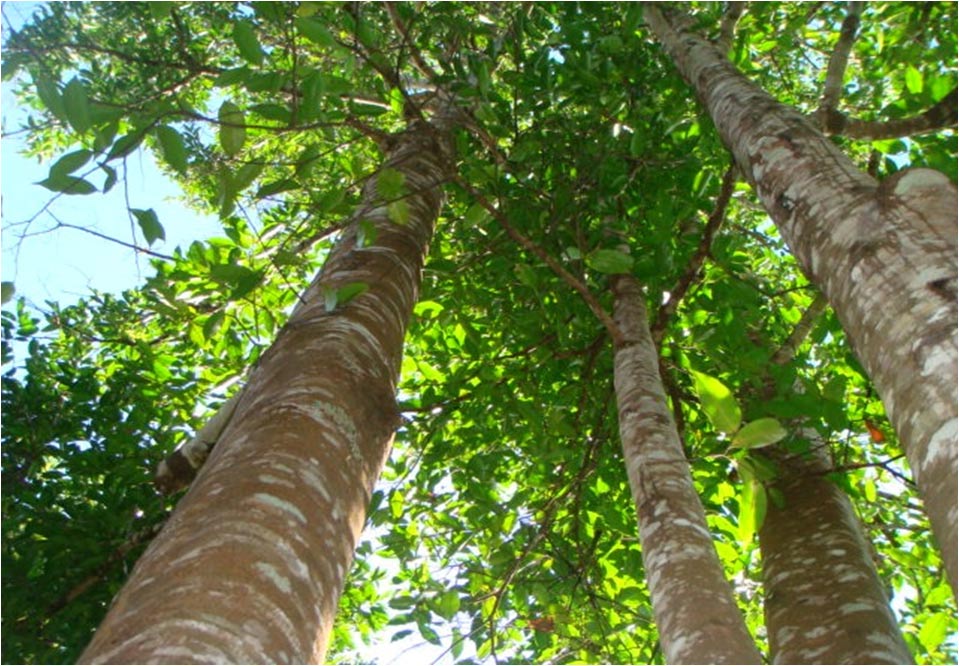Agarwood is a marvelous though pathological phenomenon. Traded as Agarwood, it is commonly referred to as (maiketsana) in the Lao PDR. It is also known as gaharu, eaglewood, aloeswood and oodh.
Agarwood, which is found in certain species of Aquilaria, is formed by a reaction to a fungal/bacterial inoculation. Inoculated trees secrete a fragrant and protective oil into areas such as (roots, branches or sections of the trunk), which gradually become harder and darker. The best grade of Agarwood is hard, nearly black, and sinks when placed in water. Normally, harvesters cut only the inoculated parts with the hopes that the tree will regenerate, producing more of this resinous wood.
Agarwoodis a fast growing; evergreen tree that normally grows to 18–21 meters, though trees up to 40 meters can also be found.
Aquilaria species that produce Agarwood are found throughout Asia. For example, AquilariaMalaccencis, which is traded the most, can be found from India to Indonesia. These trees are relatively easy to grow and experimental plantations exist in most producing countries.
Agarwood, which is the world’s most expensive incense, has a 3,000-year history in the Middle East, China and Japan. The Chinese describe its smell as a “sweet and deep but balanced fragrance” and continue to use it for religious and festive celebrations, as do Arabs, Indians and Japanese. It is also part of many traditional
pharmacopoeias, dating back to medieval times. Chinese doctors still prescribe it for colds and digestive problems. In Arab countries oil extracted from Agarwood is used as a perfume. Unlike many industrial perfumes it is suitable for hot climates: the longer it is worn the more fragrant its aroma!
Despite its unique qualities, Agarwood is rarely used in European perfumeries because of its cost and good quality synthetic substitutes are yet to be created.
Scientific Names of Agarwood:
- Aquilariamalaccensis (CITES Appendix II)
- Aquilariafilaria
- Aquilariakhasiana
- Aquilariaagallocha
- Aquilariamicrocarpa
- Aquilariabaillonii
- Aquilariagrandiflora
- Aquilariacrassna
- Aquilariahirta
- Aquilariasinensis
- Aquilariarostrata
- Aquilariaborneensis
- Aquilariabeccariana
- Aquilariabancana
- Aquilariacummingiana
- AquilariaSubintegra
Agarwood is known by different names in different countries, in accordance with the language, cultural and religious practices of a country.
- India: Agar in Hindi, from the Sanskrit word agaru; inAssam, it is known as Sasi or Sashi
- China: Chen-xiang/ hsiang, meaning sinking in water
- Vietnam: Tram huong, meaning sinking in water
- Japan: Jin-koh
- Arab countries: Oodh, since wood is pronounced in Arabia as oudh.
- Indonesia, Malaysia & Brunei name is “Gaharu”
- Europe: Eagle Wood and Aloes Wood from the Latin word aguila, meaning eagle
- Tibet and Bhutan:Agaru
- Lao PDR and Thailand: Mai ketsana
- Sri Lanka: Walla Patta
In the global markets, it is popularly known as agarwood, gaharu and oodh.
Agarwood trade and its exploitation:
Agarwood is the most expensive wood in the world and its supply only meets 40% of demand. Since there are no obvious external signs that a tree may contain it, the quantity can only be fully determined after the tree has been felled and cut open. Consequently, trees of relevant species are indiscriminately cut down in the hope of finding the wood. This has resulted in depletion of wild trees and degradation of habitats, causing a loss for Agarwood producing species with a dramatic decline in wild Aquilaria in the last few decades. In an attempt to save the Aquilaria, trading in all species require CITES (Convention on International Trade in Endangered Species of Wild Fauna and Flora) certification where companies buying and selling Agarwood internationally must issue export permits or re-export certificates.
Though it is illegal to cut or harvest this precious wood in most Southeast Asian countries, wild populations continue to be under threat, as its value is so high. It is virtually impossible to determine which species are being traded as all Agarwood reported in trade is generally referred to as Aquilaria or A. Malaccensis. Eight species out of the fifteen Aquilaria species are known to produce Agarwood, though it primarily comes from AquilariaMalaccensis and AquilariaCrassna, both of which belong to the Thymelaeccae family. It is the AquilariaCrassna species that is found in the Lao PDR.
Resin producing trees like the AquilariaCrassna, are endangered throughout their known habitats across Southeast Asia. The main reason for L.A.I.D. operating their own plantations in the Lao PDR is to protect against unsustainable harvesting of natural forests that are resulting in the near extinction of this tree genus in the Lao PDR and elsewhere. AquilariaCrassna is now listed as a protected species in the Lao PDR.
L.A.I.D. trades and harvests according to the regulations set by CITES. (Convention on International Trade in Endangered Species of Wild Fauna and Flora)
Traditional Usage of Agarwood
- The Agarwood resin is used by Traditional Chinese, Unani, Ayurvedic, and Tibetan physicians.
- Used medicinally, agar oil is a remedy for nervous disorders such as neurosis, obsessive behavior, and exhaustion.
- In Ayurvedic medicine it is used to treat a wide range of mental illness.
- The Agarwood oil termed as ‘Oudh’ in the Middle East is highly valued for its fragrance, it is worn on clothes and skin during special occasions such as Eid and Friday prayers.
- Agar oil is used in china for its psychoactive properties.
- Many religious groups prize it as meditation incense. Tibetan monks use it to bring energy to the center and calm the mind and spirit.
- In Japan, it is considered by many to be sacred, and is used to anoint the dead.
- In Buddhism, it serves as a major ingredient in many incense mixtures, and it is considered to be one of the three integral incenses, together with sandalwood and cloves.
Agarwood in Medicinal Usage
Agar oil and its products have been used in modern medicine for various illnesses such as nausea, nerves regurgitation and weakness in the elderly, epilepsy, antimicrobial, carminative (gas), smallpox, rheumatism and illness during and after childbirth. It is also used as an aphrodisiac, diuretic or antimicrobial purpose. It relieves spasms in digestive and respiratory systems, shortness of breath, chills, general pains, lowers fever, asthma, cancer, colic, digestive and bronchial complaints, abdominal pain, diarrhea, cirrhosis of the liver and as a director or focuser for other medicines. It has also been used as a treatment for lung and stomach tumors.
Insomnia
Valerian is a natural component of Agarwood resin and relieves insomnia, calming the nervous system before sleep. Inhale the fragrance deeply and it will help you sleep better, in some Arab cultures this is the norm before going to sleep.







